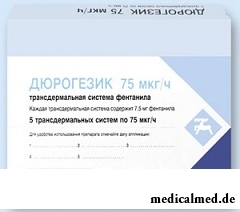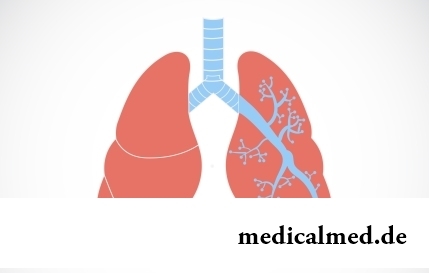





Dyurogezik
Application instruction:
 Dyurogezik – drug with analgeziruyushchy action.
Dyurogezik – drug with analgeziruyushchy action.
Form of release and structure
Dyurogezik release in the form of the transdermal therapeutic system (TTS): the squared plaster with the rounded-off corners, translucent, hermetically soldered, contains transparent gel; in gel existence of crystalline particles and vials of air is allowed; texts on an outside cover: 0,025 mg/h – pink color, 0,05 mg/h – light green color, 0,075 mg/h – blue color, 0,1 mg/h – gray color (on 1 piece in packages from the combined material, on 5 packages in a cardboard pack).
Is a part of 1 system:
- Active agent: fentanyl – 2,5 mg, 5 mg, 7,5 mg or 10 mg;
- Auxiliary components: hydroxyethylcellulose, alcohol, the purified water.
Structure of functional layers of a plaster:
- Outside protective cover: copolymer of an etilenvinilatsetat and polyether;
- Tank: ethanol (0,1 ml / 10 cm2) and fentanyl (2,5 mg / 10 cm2) in the form of water gel on the basis of hydroxyethylcellulose;
- The releasing membrane: этиленвинилацетат (controls the speed of release of active agent);
- The silicone adherent layer covered with the protective deleted film: polyester and fluorocarbon diacrylate.
Indications to use
Dyurogezik appoint at a chronic pain syndrome of average and strong expressiveness, including:
- The pains connected with oncological diseases;
- The pain syndromes of not oncological etiology demanding anesthesia by narcotic analgetics: neyropatichesky pains (at shingles (Herpes zoster), a myelosyringosis, diabetic polyneuropathy, multiple sclerosis, nerve injuries), the stump neuralgias connected with amputation of extremities.
Contraindications
Absolute:
- Oppression of a respiratory center;
- The angry, irradiated or injured skin;
- The acute and/or postoperative pains demanding the short period of therapy;
- Age up to 18 years;
- Pregnancy and period of a lactation;
- Hypersensitivity to drug components.
Relative (Dyurogezik it is necessary to apply with care):
- Chronic pulmonary diseases;
- The increased intracranial pressure, including at brain tumors;
- Bradyarrhythmias;
- Arterial hypotension;
- Liver and renal failure;
- Acute surgical diseases of abdominal organs (before establishment of the diagnosis);
- Hepatic colic in the anamnesis;
- Cesarean section and other obstetric operations (before extraction of a fruit);
- Simultaneous use with insulin, glucocorticosteroids and hypotensive medicines;
- Advanced age.
Route of administration and dosage
Dyurogezik apply locally. TTS needs to apply on absolutely dry, flat surface of skin of upper parts of hands or a trunk. For application it is recommended to choose the place with the smallest indumentum. Hair on site applications need to be sheared (not to shave off). If before Dyurogezik's use the place of application needs to be washed up, it should be made by means of clear water without use of soap, lotions, oils or other means as they can lead to irritation of skin or change of its property.
It is necessary to paste Dyurogezik right after extraction of a plaster from the soldered package. TTS on site of application should be pressed densely a palm for 30 seconds. It is necessary to be convinced that the plaster densely adjoins to skin, in particular at the edges.
Dyurogezik is expected 72 hours of continuous use. The new system can be pasted on other site of skin after removal of the plaster pasted earlier. On the same site of skin the plaster can be pasted only with a break in several days.
The dose of drug is selected individually depending on a condition of the patient (it needs to be estimated again after each application of TTS).
At the first use of Dyurogezik the size of system (dose) is selected proceeding from the previous use of opioid analgetics, by conditions of the patient and degree of tolerance. At the patients who were not accepting earlier opioids as an initial dose appoint the smallest dose – 0,025 mg/h. The same dose is applied to the patients receiving earlier Promedolum.
Upon transition from parenteral or peroral forms of opioids to Dyurogezik at patients with tolerance to opioids the dose is calculated individually.
Initial assessment of the maximum analgesic effect of drug cannot be carried out earlier, than in 24 hours after application that is caused by gradual increase in serum of concentration of fentanyl.
For successful transition from one medicine to another the previous anesthetizing treatment needs to be cancelled gradually after application of an initial dose of Dyurogezik.
If adequate anesthesia after application of an initial dose is not reached, in 3 days the dose can be increased. Further increase in a dose is possible each 3 days. For once the dose is usually increased by 0,025 mg/h, however at the same time it is necessary to consider a condition of the patient and the need for performing additional anesthesia (the daily peroral dose of morphine of 90 mg approximately corresponds to Dyurogezik's dose of 0,025 mg/h). For achievement of a dose more than 0,1 mg/h perhaps simultaneous use of several TTS. Periodically, when developing of the "breaking" pains, additional doses of analgetics of short action can be required for patients. Some patients when using a dose of Dyurogezik higher than 0,3 mg/h can need additional or alternative ways of introduction of opioid analgetics.
Side effects
- Nervous system: headache, depression, drowsiness, alarming states, confusion of consciousness, hallucination, anorexia; seldom – agitation, euphoria, a tremor, sleeplessness, amnesia, paresthesia;
- Alimentary system: vomiting, nausea, a lock, bilious colic (at patients with instructions in the anamnesis), dyspepsia, dryness in a mouth; seldom – diarrhea;
- Respiratory system: hypoventilation, respiratory depression and a bronchospasm (at overdose); in rare instances – an asthma;
- Local reactions: sometimes – skin rash, an itch and an erythema in the place of application (as a rule, pass independently for 24 hours after removal of TTS);
- Others: tachycardia, short-term muscle tension (including chest), bradycardia, hypertensia, a lowering of arterial pressure, an ischuria, the strengthened sweating, an itch, tolerance, and also physical and mental dependence; very seldom – sexual dysfunction, an adynamy, "withdrawal".
Upon transition to Dyurogezik from the accepted earlier narcotic analgetics or in cases of the sudden termination of treatment symptoms which are characteristic of cancellation of opioids are possible (vomitings, diarrheas, alarming states, a fever are shown in the form of nausea). Reduction of expressiveness of these symptoms is promoted by a gradual dose decline.
Special instructions
Dyurogezik appoint with care in the presence of the following diseases / states:
- Chronic diseases of lungs: against the background of chronic obstructive and other diseases of lungs Dyurogezik can lead to development of a number of heavy side effects (in the form of decrease in excitability of a respiratory center and increase in respiratory resistance);
- Increase in intracranial pressure: the patient showing special sensitivity to increase in maintenance of CO2, Dyurogezik it is necessary to appoint with care. Patients with the increased intracranial pressure, disturbances of consciousness and the patients who are in a coma treat risk group. Drug is appointed with care at brain tumors;
- Cardiovascular diseases: because of probability of development of bradycardia of care demands use of TTS for patients with bradyarrhythmias and arterial hypotension;
- Liver diseases: it is necessary to make careful observation of a condition of patients with liver pathologies as such diseases can lead to a delay of removal of active agent; at emergence of symptoms of overdose of fentanyl the drug dose decline is required;
- Hepatic colic in the anamnesis: Dyurogezik can raise a tone of smooth muscles of biliary tract and digestive tract therefore such patients need careful observation;
- Diseases of kidneys: at a renal failure behind a condition of patients careful control is necessary; at emergence of symptoms of overdose by active agent, it is necessary to lower a drug dose;
- Advanced age: because of risk of decrease in clearance of fentanyl and lengthening of the period of its semi-removal, and also probability of existence of hypersensitivity to effect of drug, behind a condition of elderly patients careful control is necessary; at emergence of symptoms of overdose by active agent it is necessary to lower Dyurogezik's dose;
- Respiratory depression: some patients because of probability of development of considerable respiratory depression need careful inspection for the purpose of identification of similar effects. After removal of TTS respiratory depression can proceed;
- Medicinal dependence: in cases of repeated use of opioids tolerance, and also mental and physical dependence can develop. Iatrogenic dependence during therapy by Dyurogezik is noted seldom;
- Fever / external sources of heat: at increase body temperature increases to 40 °C concentration of fentanyl therefore patients with fever need careful observation for identification of side effects, characteristic of opioids. If necessary Dyurogezik's dose is adjusted. Patients are recommended to avoid direct influence of external sources of heat to the place of application of TTS (heating lamps, intensive solar bathtubs, hot-water bottles, saunas, bathtubs with hot water, etc.).
It is necessary to watch a condition of patients at whom development of heavy side effects was noted carefully as concentration of fentanyl in plasma goes down gradually.
Plasters cannot be divided into parts, to cut or damage in any way as it can lead to uncontrollable release of fentanyl.
In need of the therapy termination Dyurogezik's replacement with other opioids needs to be made gradually, since low doses. For prevention of development of "withdrawal" it is necessary to cancel an opioid analgesia gradually.
As Dyurogezik can influence the physical and/or mental functions necessary at performance of potentially dangerous works (including driving or work with the equipment), during therapy it is recommended to refrain from participation in them.
Medicinal interaction
At simultaneous use of Dyurogezik with some medicines there can be following effects:
- Other medicines having the oppressing effect on the central nervous system including opioids, hypnotic drugs and sedative drugs, fenotiazina, means for the general anesthesia, the central muscle relaxants, tranquilizers, antihistaminic drugs with sedative action, alcoholic beverages: increase in risk of development and strengthening of hypoventilation, lowering of arterial pressure, excessive sedation (joint therapy demands special observation of a condition of the patient);
- Potential inhibitors of P450 CYP3A4 cytochrome (ритонавир): increase in concentration of fentanyl in plasma that increases probability of strengthening or lengthening of therapeutic action and emergence of side effects (the combination is not recommended);
- Nitrous oxide: strengthening of muscular rigidity;
- Buprenorphine: decrease in effect of Dyurogezik;
- Monoamine oxidase inhibitors: increase in risk of development of heavy complications.
At combined use with insulin, glucocorticosteroids and hypotensive medicines it is necessary to lower a fentanyl dose.
Terms and storage conditions
To store in the place, unavailable to children, at a temperature of 15-25 °C.
Period of validity – 2 years.
Antidepressant Klomipramin causes an orgasm in 5% of patients.

Insufficiently strongly expressed sexual desire or lack of satisfaction from sexual contacts can test time from in...
Section: Articles about health
We live during an advertizing era. Daily each person receives a solid portion of persuasive councils about what to eat to be healthy and successful. Products about which we will talk today are combined by the following circumstance: all of them are positioned as most...
Section: Articles about health
Within several decades of our compatriots convinced that the use of butter nasty affects a condition of coronary vessels. As a result the reputation of a product was impaired thoroughly a little, and many almost ceased to include it in the diet, having given preference "to safer" to vegetable fats. Meanwhile, the last researches showed that harm of butter for health is strongly exaggerated. But the product has a number of unique properties, to...
Section: Articles about health
Helminthosis is one of the most widespread diseases. Statistically, with any species of helminths it is infected porridges...
Section: Articles about health
The phenomenon of the panic attack is known long ago, but the reasons of its emergence still are up to the end not found out. It is established that more than 30% of people at least once in life become the victims of very unpleasant phenomenon: without everyones on that the reasons they have a feeling of horror, with...
Section: Articles about health
A lot of things depend on a condition of a backbone in a human body, a backbone - not only a support for a body, it also a receptacle for a spinal cord, that is why malfunctions with a backbone are so dangerous. To treat rachis diseases very difficult and long, it is much simpler and more correct not to bring to a disease. Conforming to the rules provided in this article it is possible to avoid the majority of the problems connected with a backbone including those which are considered to be age, but a cat...
Section: Articles about health
The advantage of swimming for the person is so high that this sport is not only the most popular, but also is widely applied in copper...
Section: Slideshow
Radiological methods of a research are applied in medicine more than hundred years, and thanks to them millions of lives were saved. In many cases without X-ray it is impossible to make exact idea of a condition of bodies and fabrics, it is correct to make the diagnosis. Those...
Section: Articles about health
The kid who was recently born is surrounded with love of adult family members and their cares without which the baby cannot exist. Some parents consider that gentle attachment and caress are quite enough that the child correctly developed and was happy, but it not so. It is important to know as much as possible about specifics of care of the baby, the reasons of his behavior and possible problems. Only the "able to see" love will provide to the little man that it is necessary for him....
Section: Articles about health
White teeth and the Hollywood smile – a dream of many people. Long time was considered that a plaque on teeth and change of their color – destiny of those...
Section: Articles about health
Small appetite at the child – the complaint which pediatricians should hear practically from each mother. Most often it is carried to the category of children's whims, however the refusal of food in certain cases can be to alarming symptoms therefore it cannot be ignored....
Section: Articles about health
The Genetically Modified Organisms (GMO) are plants or animals (as a rule, agricultural) to whose genotype purposeful changes were made. Opposition of supporters and opponents of inclusion of such organisms in foodstuff always was very acute. Not only scientists and dietitians, but also a large number of the people who are not specialists in this question are involved in active disputes today....
Section: Articles about health
Work of a brain is extremely complex and in many respects is not studied yet. It is confirmed also by the features of thought processes which are shown in...
Section: Articles about health
Life of the modern child is extremely active and difficult. Information strain which is experienced by the school student and did not dream pupils of last times. Careful parents, wishing well to the children, will organize a set of additional classes in circles, sports...
Section: Articles about health
Practically each person is familiar with the annoying, pulling, unscrewing pains caused by overcooling of muscles of a back. In certain cases inflammatory process is not limited to discomfort, being followed by emergence of hypostasis, consolidations, temperature increase. At the wrong treatment the acute miositis can lead to a chronic disease or aggravation of other pathologies of a back (vertebral hernia, osteochondrosis) therefore it is important to pay attention to symptoms of an illness in time and to start to...
Section: Articles about health
The technique of acupuncture (acupuncture) is used in the medical purposes more than three and a half millennia. It widely races...
Section: Articles about health
They say that to ensure health and longevity of people it is obliged. Really, at competent approach to these questions, minimization of an adverse effect of many factors does not represent a special problem. Practically everyone has an opportunity to play sports...
Section: Articles about health
Life of the modern woman is very difficult. Opportunities to realize itself are wide: it not only education and career, but also the most various hobbies from sport before needlework. It is not less important to build private life, paying an attention maximum to children, the husband, parents, friends. For all these affairs there is catastrophically not enough time therefore each of us tries to cut down as far as possible its expenses on necessary, but not the most fascinating housework. With it we are successfully helped by means...
Section: Articles about health
The dietology, as well as other sciences, does not stand still. Food stuffs are exposed to comprehensive study, and scientists receive new and...
Section: Articles about health
Iodine - one of thirty most important microelements in our organism. The main role of iodine consists in synthesis of thyroid hormones of a thyroid gland - the substances which are responsible for the majority of exchange processes of an organism. It is known that thyroid hormones consist...
Section: Articles about health
Herpes simplex of the first type (the infectious disease which is shown periodic bubble rashes on lips is called) – one of the most widespread illnesses. Statistically, only 5% of inhabitants of our planet are unreceptive to its activator, and the reasons of this feature are still not found out. Other people are virus carriers....
Section: Articles about health
Sometimes it seems that modern society was divided into two camps: representatives of the first are sure that has to for contraception отвеч...
Section: Articles about health
Memory is an ability of the central nervous system to fix, keep and as necessary to reproduce information on knowledge or skills received by the person or an animal during life. The mechanism of this process is up to the end not studied....
Section: Articles about health
Reactive pancreatitis - the disease which is characterized by inflammatory process in a pancreas which arises most often because of excess activity of digestive enzymes. It − the emergency state which treatment has to take place in surgical department under control of doctors. The acute inflammation of gland can become the reason of its transition to a chronic form, and also development is purulent - necrotic pancreatitis which the extensive necrosis of fabrics can follow. Zabolev...
Section: Articles about health
Any person who faced a disease knows that treatment costs expensive. It belongs also to consultations qualified the specialist...
Section: Articles about health
Beauty shop – the place which is associated only with positive emotions: joy, pleasure, relaxation. However visit of salon where work with biological material of clients, not always harmlessly is conducted. Today it is known Bol...
Section: Articles about health
When overcomes feeling of hunger, and an opportunity to have dinner fully is absent, having a snack − the meals, small on volume, stabilizing sugar level in blood comes to the rescue. The relation of nutritionists to having a snack more often negative, but only because as snack people choose the most caloric products with the increased amount of "bystry" carbohydrates: cookies, rolls, chips, candies. Nevertheless, the advantage of having a snack is obvious to weight loss: the person avoids strong feeling of hunger...
Section: Articles about health
